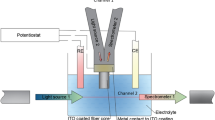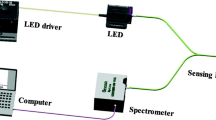Abstract
Fiber optic ion-microsensors based on luminescence decay time have been developed for chloride and potassium. The fiber tip coatings consist of the respective ion-selective lipophilic ion carrier, plasticized PVC, and the ruthenium(II) tris-4,4′-diphenyl-2,2′-bipyridyl ion-pair with Bromothymol Blue [Ru(dibipy)3(BTB)2] as a proton donor. The efficacy of radiationless fluorescence energy transfer from the donor (the ruthenium complex) to the acceptor (BTB) is mediated by the ion concentration within the samples. The chloride response is based on the co-extraction of chloride along with protons from the aqueous sample into a plastiziced PVC membrane, whereas in the presence of potassium ions in the sample, the neutral BTB becomes deprotonated on extraction of potassium ions, with the release of protons. Both processes result in a change in BTB absorbance. The absorption band of deprotonated BTB overlaps significantly with the emission band of the ruthenium complex, allowing radiationless energy transfer to take place.
Similar content being viewed by others
Author information
Authors and Affiliations
Additional information
Received July 8, 1998. Revision November 10, 1998.
Rights and permissions
About this article
Cite this article
Werner, T., Klimant, I., Huber, C. et al. Fiber Optic Ion-Microsensors Based on Luminescence Lifetime. Mikrochim Acta 131, 25–28 (1999). https://doi.org/10.1007/s006040050005
Issue Date:
DOI: https://doi.org/10.1007/s006040050005




